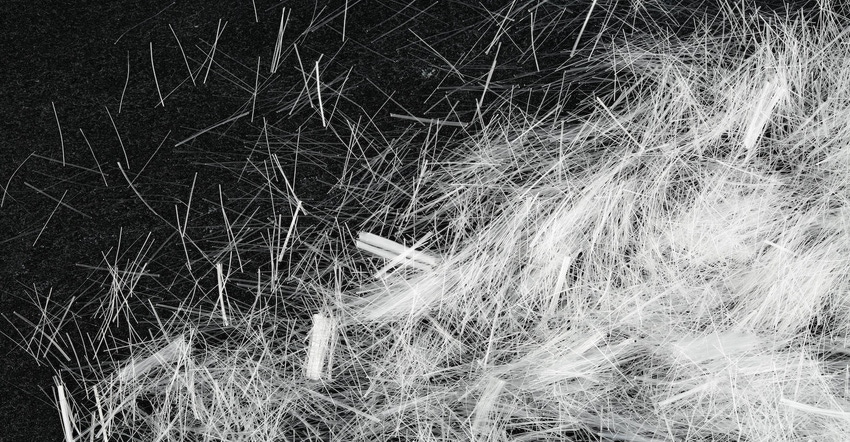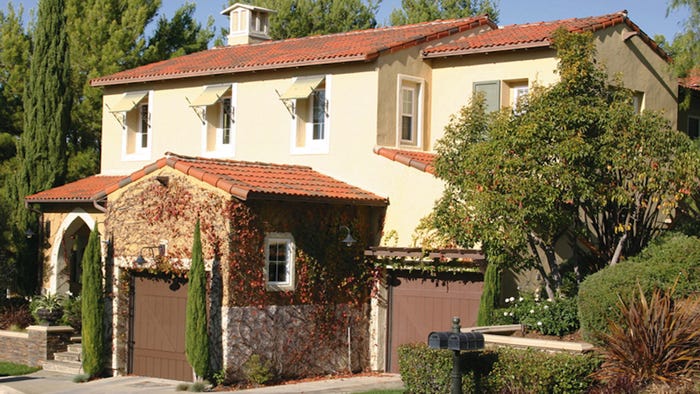Reasons to Use Fiber Over Rebar for Concrete Reinforcement
Using fibers as reinforcement when they’re a viable option can provide distinct advantages, including increased strength and preventing large cracks, according to several experts.

The tensile strength of concrete is only one-tenth of the material’s compressive strength, but using fiber-reinforced concrete can increase tensile strength and prevent larger cracks from forming, said expert presenters during a World of Concrete educational session recently.
Tyler Ley, PE, a professor of civil engineering and construction at Oklahoma State University, spoke with Jerry Holland, PE, vice president and director of design services at Structural Services Inc., about some of the advantages of using fiber-reinforced concrete.
“Fibers do the exact same thing as rebar,” Ley said, but added rebar is not as good at stopping cracks. Conversely, when compared with rebar-reinforced concrete, Ley said fiber-reinforced material is not as good at carrying loads. “Rebar carries load after concrete cracks,” Ley said. “Think of rebar like a bone in your arm.”
Ley compared fibers to stitches and said they can prevent small “microcracks” from becoming larger.
Holland said he worked on one of the first steel-fiber slabs in the U.S. nearly 45 years ago. In the decades since, he said fiber-reinforced characteristics have improved to a “tremendous degree” with both user friendliness and crack control.
Holland thought that fibers would revolutionize the industry, but he said that isn’t the case. Nevertheless, Ley said fiber-reinforced concrete has revolutionized certain types of projects, like industrial-grade slabs.
Ley said microsynthetic, macrosynthetic and steel fibers are still underutilized in crack-sensitive projects. He said many builders don’t think to use the materials, despite microsynthetic and macrosynthetic fibers having the added benefits of being able to provide reinforcement without the risk of corrosion that comes with steel.
According to ASTM C1116, there are four types of material from which fibers to reinforce concrete can be produced: Type I—Steel Fiber-Reinforced Concrete; Type II—Glass Fiber-Reinforced Concrete; Type III—Synthetic Fiber-Reinforced Concrete; and Type IV—Natural Fiber-Reinforced Concrete.
The Pennsylvania Aggregates and Concrete Association’s “Things to Consider About Fiber-Reinforced Concrete,” an information guide published on its website, said synthetic fibers are the most used and may be characterized as macrofibers and microfibers.
“Microfibers are used primarily to minimize cracking due to plastic shrinkage or plastic settlement in concrete. They provide much needed reinforcement when early age concrete has limited tensile strength and may be manufactured from polypropylene, polyethylene, polyester, nylon or other synthetic materials such as carbon, aramid and other acrylics.”
PACA’s information guide about fiber-reinforced concrete also touches on the characteristics of macrofibers.
“Macrofibers usually have lengths greater than 1.5 inches and increase the post-crack tensile strength and ductility of concrete. They are a proven cost-effective alternative to traditional welded-wire or rebar reinforcement where temperature and shrinkage reinforcement (secondary reinforcement) are a consideration.”
At the WOC session titled “Fiber Reinforcement for Slabs: What It Will and Will Not Do,” Ley said a common misconception among builders is that using fibers as a reinforcement material is unaffordable.
But he suggested the cost of not using fibers when they’re an applicable choice can be more costly in the long run.
“Can you afford to patch cracks? Can you afford to deal with all the claims?” Ley asked.
Holland, who has presented on a variety of topics over the years at WOC, said that fiber-reinforced concrete can be especially useful in specialized circumstances, like placement on bridge decks, where crack prevention is of high importance.
Macrosynthetic fibers will affect concrete’s slump, but they won’t provide a commensurate reduction in workability, Holland said.
“It’s just about getting the mix right,” he said.
What to expect
Ley and Holland also said there are some basic things to keep in mind when using fiber-reinforced concrete.
Holland said fiber-reinforced concrete can provide more joint spacing and prevent curling of the slab.
“Your slump will be impacted, but your workability may or may not,” Ley said. “There are two different things…we know how you finish isn’t just about slump. How you pump is not necessarily just about slump.”
About the Author(s)
You May Also Like




